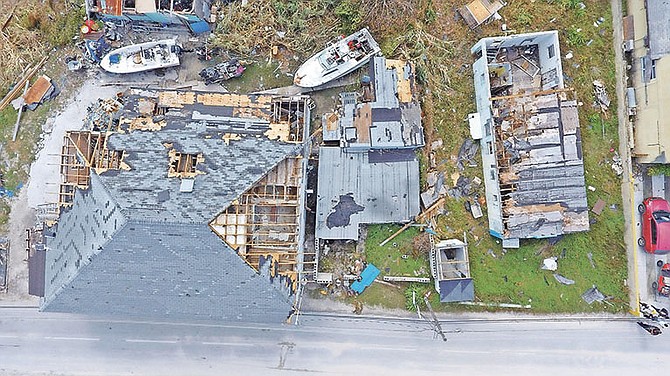By KHRISNA RUSSELL
Deputy Chief Reporter
krussell@tribunemedia.net
THE Minnis administration has made it a priority to map out areas in the country most vulnerable to devastation from future hurricanes nearly three months after Hurricane Irma devastated several islands of the Bahamas, Prime Minister Dr Hubert Minnis said yesterday.
The government, he said, is also building capacity in the Family Islands to allow for quick responses in the immediate aftermath of a disaster.
Speaking during the official opening of the 10th Comprehensive Disaster Management (CDM) Conference at the Melia hotel, the prime minister said countries in the region must press, via CARICOM, for assistance that was promised by developed countries to mitigate against the effects of climate change.
“Here in The Bahamas, our NEMA (National Emergency Management Agency) team met with CDEMA (Caribbean Disaster Emergency Management Agency) coordinating units to discuss the country’s work programme and its alignment with national goals identified in the regional Caribbean Disaster Management strategy,” Dr Minnis told conference participants.
“Our priorities are mapping out vulnerable areas and community preparedness. We are building capacity in our Family Islands and working to bring communities to a point where they can respond as quickly as possible in the immediate aftermath of a disaster including logistical capacity.”
Earlier in his address, Dr Minnis also said: “Tropical storms are likely to bring higher wind speeds, more precipitation and bigger storm surge in the coming decades. As small island developing states, we are at great risk of climate change, we must develop new mindsets and protocols in this era of super storms.
“By example, because of the projected path of Hurricane Irma and the potential destruction, the Bahamas government instituted an emergency evacuation to New Providence for the residents of several islands and communities. This was the greatest such evacuation . . . in the history of The Bahamas.
“As a region, we must continue to press through CARICOM the alliance of small island states, the United Nations and other international forums for the promised assistance from developing countries to help countries in our region to mitigate against the effects of climate change overwhelmingly caused by developed countries.
“We are constantly reminded that the countries in our region are located in one of the most hurricane prone areas in the world. The risk we face threatens our fragile economies and demands that we have in place sound disaster risk management systems. We must continue to build disaster resilient communities through partnerships for resilience.”
Ahead of Irma’s arrival, some residents of MICAL, Ragged Island and Bimini were evacuated into New Providence. Some outlying areas of Grand Bahama were also evacuated into inland communities.
In the days following Hurricane lrma’s passage, The Tribune was told the government incurred costs of about $1.5m.
The sum was said to cover air transport and shelters. However, The Tribune was told in September a final tally was not yet available as the figure was still rising.
The government has said restoration efforts following Hurricane Irma will cost the country “tens of millions”.
Earlier this year, National Emergency Management Agency Director Captain Stephen Russell reported that half-a-million dollars had been spent on evacuation and repatriation exercises.
He said the agency had conducted some 23 flight commissions, with about 1,400 people evacuated by the government.
Capt Russell estimated that about 1,000 of them had been repatriated by the government to their island, with some using their own expenses to return to their home.
He said restoration efforts that involve rebuilding people’s homes is unsustainable, and it may be time to find a new formula.





Comments
Greentea 6 years, 4 months ago
let me save you the money- the whole damn country! what a waste of time
ohdrap4 6 years, 4 months ago
which, the insurance companies ahve known all along, and that is why there is no difference in premium rate anywhere in the bahamas.
Dawes 6 years, 4 months ago
The insurance company are wrong for that. If i live on the shore and you live in the middle of Nassau i should have to pay more, as i am more at risk. They should price based on where you are rather then the country as a whole. Older communities on Nassau were built in less risky areas, new ones out South, West on the sea front (think Sandyport and Love beach) are riskier so should cost more.
bogart 6 years, 4 months ago
Should areas of risk from hurricane not also include the bigger picture of areas of risk from Climate Change, rising sea levels, temperature which is everywhere??? Insurance vompanies should not unilaterally impose higher fees for those who live on the seashore as many homes being built on the seashore may have better building standards than many of those inland.
sealice 6 years, 4 months ago
what you gat 1 sharpie and drawin circles around the whole region?
hrysippus 6 years, 4 months ago
Parts of the island will always flood, .. ..... Turning the ground to a sea of mud. ........ The twenty nine hurricane, ...... ....... Brought plenty wind and plenty rain... ...... The Ol' timers told that in Palmdale, ... ........ Waters deep enough for boat to sail.. ... ........ The waves broke right over the then Hog Cay, .......
Breaking waves from sea to sea.. ... ........ The shopping centre at East Bay . ............ Would've been three feet under on that day, ,,,,,,,,,,,,, Most high hills in Nassau town, . ............... Have been sold for fill and taken down. ................. . I think we all should learn to swim, ........ ........ And when the water rises jump right in...........
Sign in to comment
Or login with:
OpenID